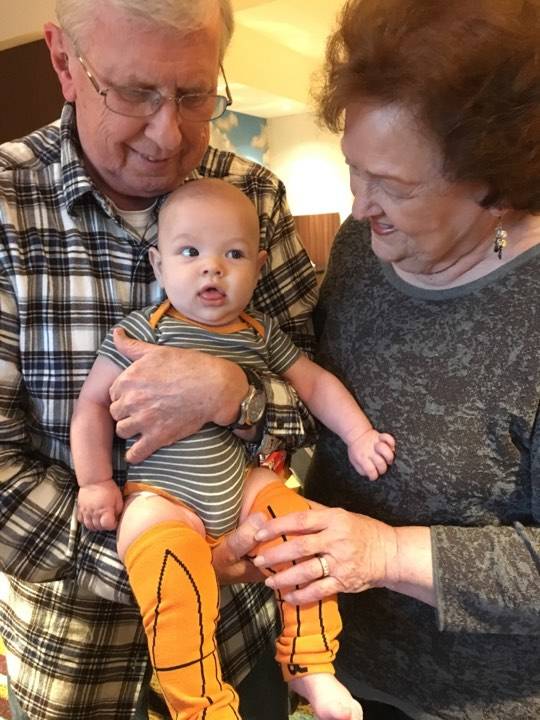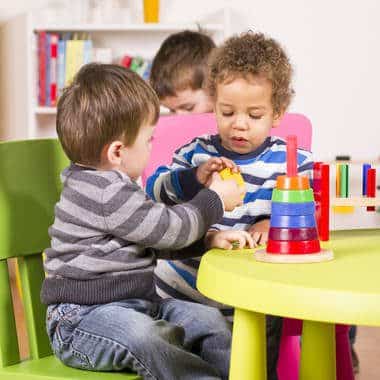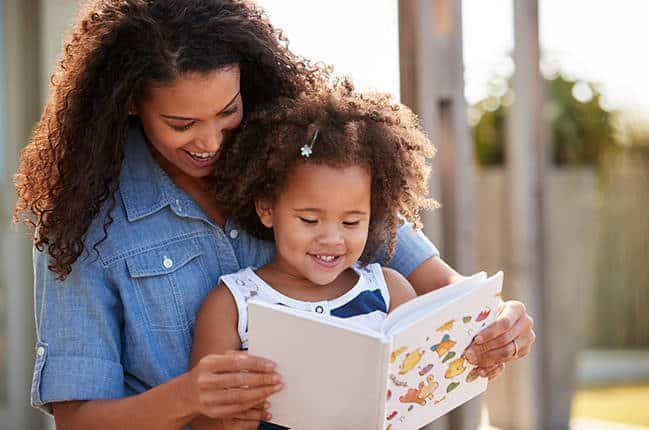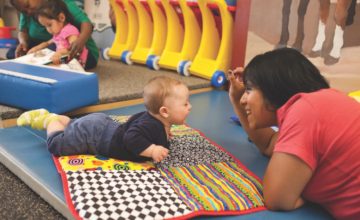Abstract
This article is an excerpt from the ZERO TO THREE Critical Competencies for Infant-Toddler EducatorsTM Course Curriculum, module SE-6: Promoting Children’s Sense of Self and Belonging. The course supports development of the essential skills educators need to optimize the social–emotional, cognitive, and language and literacy development of all infants and toddlers. For more information about the ZERO TO THREE Critical Competencies for Infant-Toddler EducatorsTM and related suite of products and services, visit www.zerotothree.org/criticalcompetencies.
Who am I? The words may be small but the question is one of the most significant ones in life. As might be expected, this fundamental aspect of being human begins construction in infancy.
A person may understand who he or she is from many different perspectives. Those perspectives, too, can be seen in very young children.
I Am My Physical Self
Because very young children are so sensory driven, one of the earliest facets of their identity to develop is their awareness of their physical self—their own body.
Babies seem quite fascinated by playing with their own hands and feet, alternately touching, moving, and looking at them. This feedback helps them identify their own body, especially when they compare the sensations with touching someone else. Touching their own arm feels different than touching someone else’s arm. Repeatedly, they move and notice how their bodies feel. As they gain new physical abilities—crawling, climbing, walking—they have more data to add to their understanding of their own physical bodies.
Seeing their own image becomes more and more interesting as well, as babies gradually come to understand the image they see is them. Scientists tell us that before their first birthday, most babies react differently to a video of themselves than to a video of another familiar person. Soon after, they can distinguish between themselves and someone else’s image in a mirror.
By 2 years old, children have gathered enough information about their physical selves that they can identify themselves in photographs. At the same time, babies and toddlers are also gathering information about other people as separate from themselves, constantly making comparisons between their own bodies and images and the bodies and images of others. These comparisons help them gain a growing understanding of the distinction between self and others.
I Am What I Can Do
Closely related to “myself as my body” is “myself as my abilities.” The first 3 years of a child’s life are packed with learning and mastering new physical abilities. Young children seem to get a great deal of satisfaction practicing their new abilities for the pure enjoyment of it. They also, however, quickly pick up on the enthusiasm and pleasure familiar adults often express toward achieving early physical milestones. “Look at me!” soon becomes a regular expression in toddlers’ vocabulary as they share their growing understanding of themselves as achievers.
Young children’s motor skills are not the only abilities they celebrate. For example, after babies start vocalizing, they seem just as fascinated with the sounds they can make as the movements they can make. They experiment with different kinds of vocalizations and with how loud they can make them! It’s just another kind of information that tells them more about their physical selves and the control they are gaining over their bodies.
These physical attributes and abilities make up a large portion of young children’s perception of themselves. Even older preschoolers, when asked to talk about themselves, focus almost exclusively on what they look like, what they like to play with, and what they physically can do.
I Am What Others Say I Am

When Grandma pulls out her grandson’s family picture album and looks through the pictures one by one, describing him and what was happening in each photo he is in, she is helping him build a narrative—a story of who he is within the context of his family. Photo: ©JBrecount
The physical self is not the only aspect of self very young children are constructing. During their first 3 years, children are also learning about their own and others’ internal selves—abstract attributes of themselves and other people that are mental, emotional, or aspects of their personality. The sense of self each young child is building also includes abstract labels and descriptions applied to them by other people.
Names
One of the first abstract labels young children attach to their identity is their name. Personal names are a great example of aspects of our identity we learn from other people. A baby learns that this special word somehow uniquely represents her because of the unique way her closest adults use it around her. After many, many repetitions, in many different situations, the label becomes attached to her understanding of who she is. (It also explains why she is so confused and even angry when she learns another person has her same name!)
Descriptive Words
But names are just the beginning. Every time an adult makes comments to a child that include descriptive words about what he is like—whether positive, negative, or neutral—it provides additional data that are added to his mental structure of who he is. If we give that statement serious thought, it should give caring adults pause and motivate us to be more aware of our language toward young children. Notice how many of our descriptions are framed in terms of traits (i.e., who they are) versus behavior (i.e., what they do).
This is important because, just like with a name, if repeated enough, adults’ descriptions or labels of children’s traits—who they are—become part of their self-image, a part that becomes more and more ingrained over time, and understood as something that can’t be changed and that they have no control over. When we attach a description to their behavior, on the other hand—to what they do rather than who they are—children build a sense of control over that part of themselves. They learn that they can change their behavior, make different choices, and see different results. Psychologists call this perspective having a sense of agency and consider it a very important aspect of a positive, healthy development of self.
Shared Memories
Another way young children learn to think about themselves is through the memories others share with them. It’s called the remembered self by child development experts and is the internal picture, or model, children construct over time based on the personal stories and memories of events that they have been part of that adults recall with them. Have you ever noticed how much toddlers and preschoolers love seeing pictures of themselves when they were babies and hearing stories about when they were younger? Their fascination reflects their growing understanding of their own history. When Grandma pulls out her grandson’s family picture album and looks through the pictures one by one, describing him and what was happening in each photo he is in, she is helping him build a narrative—a story of who he is within the context of his family. When he goes to school and he looks at the photos of last week’s field trip to the pumpkin farm, he is building a story of who he is, what he has done, and where he belongs in relation to his educator and classmates.

The concept of personal possession stems from a very healthy, normal advancement in their understanding of self. Photo: ©istock.com/dcdp
He is recounting memories that form his autobiography—his remembered self. These personal stories and memories help him understand himself in the contexts of relationships and experiences, which will become an increasingly important factor shaping how he thinks and feels about himself in the years to come.
The remembered self in the context of relationships is one example of the interplay between a child’s sense of self and sense of belonging to a group. A child’s developing sense of who she is, is shaped in part by the groups—family, classroom, and others—to which she belongs. On the other hand, the person she is also influences the relationships she builds and the group as a whole. The sense of one’s individual self and the sense of belonging to a group are both important to nurture.
He is recounting memories that form his autobiography—his remembered self. These personal stories and memories help him understand himself in the contexts of relationships and experiences, which will become an increasingly important factor shaping how he thinks and feels about himself in the years to come.
The remembered self in the context of relationships is one example of the interplay between a child’s sense of self and sense of belonging to a group. A child’s developing sense of who she is, is shaped in part by the groups—family, classroom, and others—to which she belongs. On the other hand, the person she is also influences the relationships she builds and the group as a whole. The sense of one’s individual self and the sense of belonging to a group are both important to nurture.
I Am My Connections to People, Places, and Things
Another aspect of young children’s sense of self is the emergence of a sense of ownership of people, places, and things, especially those they have strong emotional connections to (see Box 1). As anyone who has been around toddlers for long knows, they begin to take personal ownership very seriously! Although their frequent claims of “MINE!” can be annoying to adults, it may help to remember that the concept of personal possession stems from a very healthy, normal advancement in their understanding of self. To even have the idea an object belongs to me (and not you!), I first must have an understanding of myself as a person who is separate from others and who can want, have, give, and take objects.
This strong sense of connection to people, places, and things can create struggles in a group setting where there are people (e.g., educators), places (e.g., play areas), and things (e.g., toys) that “belong” to everyone, mixed together with people (e.g., parents), places (e.g., cots and cubbies), and things (e.g., personal clothing, sleepy toys, bottles) that belong only to one child.
Toddler Property Laws
If I like it, it’s mine.
If it’s in my hand, it’s mine.
If I can take it from you, it’s mine.
If I had it a little while ago, it’s mine.
If it’s mine, it must never appear to be yours in any way.
If I’m doing or building something, all the pieces are mine.
If it looks just like mine, it is mine.
(Author Unknown)
Shared ownership is a really tough concept for young children, especially in Western cultures where personal ownership is a pervasive value, and communal, shared ownership isn’t as common as in some other cultures. For some children it can be even more difficult. Circumstances that cause frequent changes in living arrangements or a traumatic event that results in a significant loss of possessions will affect a child’s relationship to possessions, making sharing an inappropriate demand of the child for the time being.
The challenge of knowing how to help motivate young children to share people and things when appropriate is a real one for educators. For all of us, our connections to emotionally significant people and things are an important part of who we are. Infants and toddlers are only beginning the process of trying to make sense of the strong attachment they feel toward certain people and things and to understand what and who belong to them versus what and who are shared.
In each of these facets of identity, educators play a big role in infants’ and toddlers’ growing sense of who they are (see Box 2). Understanding them can help educators be more intentional and positive in that role.
Identity, Self-Esteem, and Belonging in Early Education Settings
Editor’s note: The following is a conversation with ZERO TO THREE
Board Member Ross Thompson, excerpted from video included in the
ZERO TO THREE Critical Competencies for Infant–Toddler EducatorsTM
Course Curriculum, module SE-6: Promoting Children’s Sense of Self
and Belonging.
It’s remarkable the effect that an early educator can have on a baby’s or toddler’s sense of self. And all of this is conveyed implicitly of course, because it doesn’t matter that you might say to a baby “you are a wonderful child” but rather it is your sense of pleasure in what you are doing and in who they are—it is your almost embarrassingly enthusiastic response to what they are showing you and what they have accomplished. It is that sense of confidence you have as you are working alongside them as they are trying to get through a tough situation that conveys that you are utterly confident that they can succeed. And if they don’t succeed, that you are also there to help. Children at this very early stage are absorbing implicitly a sense of themselves by how educators act in relation to them, and with them and along side them, in relationship with them.
Self-Esteem
We know that young children are developing a sense of themselves as it is reflected in how they are relating to people who matter to them. Years ago a famous psychologist talked about this as being “the looking-glass self,” the mirrored self, where you see who you are by how others perceive you. It is the reflection of their evaluation that children take into themselves and incorporate into their sense of who they are. And this begins very early. It begins in how a parent or care provider applauds their accomplishments and contributes to a sense of pride, or criticizes the child’s behavior and contributes to a sense of guilt. But that may also turn into shame, and shame being not just “what I have done is inappropriate” but “who I am is unacceptable.” So how parents and caregivers are communicating their own sense of a child to the child themselves, and how that is being incorporated into their own self-esteem is really important. In our research we have found that a child’s sense of self at 5 years old was predicted by how their parents were interacting with them or relating to them a year earlier. A child who had a secure attachment to their parent at 4 years old had a very positive sense of self at 5. On the other hand, a parent who was reporting a lot of stress or depressive symptomology at 4, that child had a more negative
sense of self at age 5.
Belonging
One of the remarkable experiences of a baby or toddler in an early education setting is that now they are part of more groups than the family. They are part of a play group, a classroom group, where they are connected to other adults and to other children. And it’s easy to miss the signs of that baby’s or toddler’s sense of connecting to these other partners unless you know what to look for. Part of the looking for it is recognizing that they are enthusiastic and excited to be there. Parents will talk about getting ready for a tearful goodbye but the child is already heading off to the play group to join their friends. We can see it in the ways that babies will play in a more complex way with children they know compared to children they don’t know, reminding us of how the familiarity of a partner helps to establish a framework or the groundwork for the child to play in more complex and sophisticated ways. Of course it’s also reflected in the inquiries that toddlers make about the experience of their peers. So if a child becomes distressed, for example, a toddler may, with their limited vocabulary, or maybe even
with a sign, ask why is that child crying? A baby will often cease what they are doing and show what we call “concerned attention” where their face sobers up and they are attentively still to that other child’s distress, so already that connection, that sense of being a part of a group is set in place.
Ross Thompson, PhD, is distinguished professor of psychology at the
University of California, Davis, and is director of the Social & Emotional Development Lab. He is past president of the ZERO TO THREE Board of Directors. He has served twice as associate editor of Child Development, was a Senior National Institute of Mental Health Fellow in Law and Psychology at Stanford University in 1989–1990, and served on the Committee on Integrating the Science of Early Childhood Development (1998–2000) and the Committee on the Science of Children Birth to Age 8 (2013–2015) of the National Research Council/Institute of Medicine.
Author
Kathy Reschke, PhD, is a senior content specialist for the Professional Development and Workforce Innovations (PDWI) department at ZERO TO THREE. In this role, Dr. Reschke works as part of a team to support the conceptualization, development, implementation, and enhancement of ZERO TO THREE’s multidisciplinary, competency-based professional development products and services for individuals and organizations.





